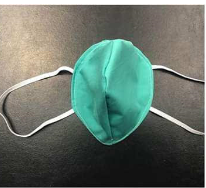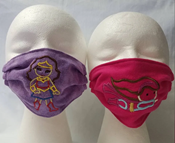PATTERNS: General Pattern Instructions
- Yarn for projects should be washable (not wool).
- You may use partial skeins left over from projects. Combine colors into stripes.
- Seasonal colors, pastels, football team colors, bright colors, etc., may be used.
- Wash any hats that become soiled in construction. Do not use fabric softeners, perfumes, or sachet.
- Package hats, booties, etc., in plastic bags or tissue paper to protect them from soil. Several items can be placed in one plastic bag.
- Hat sizes are approximate. Your gauge does not have to be perfect. The hospitals will find babies to fit all size hats. It's important to keep tension loose so hats have lots of stretch.
- Fabric paint is a suitable alternative to embroidery on finger puppets.
- Please keep pairs of bootees together with a safety pin.
- Bootees stay on best if there's a ribbon or chained yarn tie around the ankle.
- Pom pom makers are available at your local craft store or make one as follows. Cut a 1.5" x 2" piece of cardboard. Wrap yarn around the 1.5" dimension at least 40-50 times. Slide yarn off the cardboard and with a yarn (8" length) tie around the middle. Cut the loops and trim the pom-pom until circular. Tie onto top of hat.
- To attach a satin ribbon bow to the top of a hat, thread ribbon onto a tapestry needle. Weave in and out of the top of the hat. Tie bow.
When knitting or crocheting please keep in mind the approximate sizes for these infants. Head sizes of the infants in the Neonatal Intensive Care units vary from the size of a large walnut or lime to larger than normal for full-term babies. Extra-large preemie, large preemie, medium preemie and full-term are the most needed sizes.
To give you an idea of the size needed for preemie apparel use this chart.
PREMATURE & NEWBORN SIZE CHART
Reprinted with permission
http://www.touchinglittlelives.org
| Gestational Age (weeks) | Weight (pounds) | Height (inches) | Head Circumference (inches) | Abdominal Circumference (inches) |
|---|---|---|---|---|
| 14 | 1½ | 13½ | 9 | 8 |
| 26 | 2 | 14 | 9½ | 8½ |
| 28 | 2½ | 15 | 10 | 9½ |
| 30 | 3 | 16 | 10½ | 10½ |
| 32 | 3½ | 17 | 11½ | 11 |
| 34 | 4½ | 18 | 12½ | 12 |
| 36 | 5½ | 19 | 13 | 12½ |
PREMATURE & NEWBORN SIZE CHART: FOOT SIZES
Reprinted with permission
http://www.touchinglittlelives.org
| Small Preemie | Large Preemie | Full Term | |
|---|---|---|---|
| Weight | 1 - 3 pounds | 3 - 5 pounds | 6 - 10 pounds |
| Foot Length | 1" - 2" | 2½" - 3" | 3" - 3.5" |
Abbreviations
| CROCHET PATTERNS | |
|---|---|
| Ch | Chain |
| sl st | slip stitch |
| sc | single crochet |
| dc | double crochet |
| st(s) | stitch(es) |
| tog | together |
| inc | increase |
| dec | decrease |
| rep | repeat |
| rem | remaining |
| KNITTING PATTERNS | |
|---|---|
| K | Knit |
| P | Purl |
| st(s) | stitch(es) |
| tog | together |
| in(s) | inch(es) |
| K1 | Knit one stitch |
| P1 | Purl one stitch |
| K2tog | Knit two stitches together |
| P2tog | Purl two stitches together |
| YON | Yarn over needle (to create a stitch) |
| ( ) | Instructions in brackets are to be repeated a specified number of times |
| Yfwd | yarn forward |
| inc | increase |
| dec | decrease |
| rep | repeat |
| rem | remaining |
| Kb | knit into back of stitch |
| PSSO | Pass slipped stitch over |
What size blanket should I make?
Well, baby blankets are not standard sizes. Some of the hospitals request 30" x 30" to 36" x 36" blankets. Other hospitals request 13" to 15" square blankets. Here are some suggested sizes:
| Average baby blanket: |
30" to 36" square 35" x 41" |
| Receiving blankets of flannel: |
30" to 36" square 30" x 30" |
| Crib size is a little larger: | 36" x 50" |
| Carriage size is smaller: | 24" x 28" |
| Afghans | usually 50" x 64" to 58" x 75" |
| Lap robes for wheelchairs | vary from 28" x 36" to 48" x 60" |
| Knitting Needle Conversion Chart | |
|---|---|
| UK | US |
| 2 mm | 0 |
| 2¼ mm | 1 |
| 2¾ mm | 2 |
| 3¼ mm | 3 |
| 3½ mm | 4 |
| 3¾ mm | 5 |
| 4¼ mm | 6 |
| 4½ mm | 7 |
| 5 mm | 8 |
| 5½ mm | 9 |
| 6 mm | 10 |
| 6½ mm | 10½ |
| 8 mm | 11 |
| 9 mm | 13 |
| 10 mm | 15 |
General Information for Sewing Projects
- All sewing pattern grids should be scaled to 1" X 1".
- A few hospitals request flame retardant flannel for kimonos, etc. Otherwise, cotton flannel, cotton knit or terry may be used.
- Do not use fabric softeners or fragrant rinses on the fabrics.
- Do not attempt to machine stitch adhesive-backed velcro. Buy regular (non-adhesive backed) Velcro for kimono fasteners.
- Edges on kimonos, receiving blankets, diaper shirts, etc. can be serged, bound, zig-zagged, or finished with decorative/overcast stitches.
- Do not attach buttons (or anything that an infant might swallow) to kimonos, toys, diaper shirts, etc.
- Fabric paint is a suitable alternative to embroidery or felt cut-out eyes, etc. on finger puppets or toys.
- Secure ribbon with glue so that it cannot be removed and swallowed.
Perhaps you can interest young people in making some Care Wear projects. Beginners can manage the diaper shirt, stuffed animals, or felt finger puppets -- with some direction and supervision. Perhaps a Brownie or Girl Scout troop is in need of a service project. (Substitute textile paint in squeeze tubes for embroidery on stuffed toys.)


